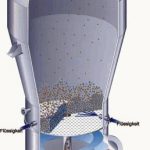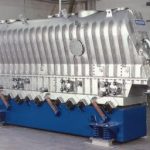Suspensions and solutions can be dried carefully in fluidised-bed dryers. If the dryers are combined with spray-granulation devices, fine particles or granulates can be produced with precisely the desired shapes and sizes. For this purpose, the dryers must be dimensioned specifically for the planned task.
Mathias Trojosky
Continuous fluidised-bed granulation drying combines several process steps in a single stage:
- Concentration of the liquid
- Shaping by granulation or agglomeration
- Simultaneous drying
- Grading and dust removal
In a fluidised-bed spray-granulation unit, a liquid containing soluted solid is injected directly into the granulates of the fluidised bed through one or more nozzles. As the water or solvent evaporates, the solid matter accumulates on the granulates in the form of shells, thus increasing their size. When the granulates reach the desired size, they fall down the classifying tube, in the opposite direction to the flow of grading air, and are removed. Fine particles which act as the seeds for the creation of new granulates are either fed in from outside the machine or, in many cases, generated automatically by the natural product erosion in the fluidised bed. These particles are removed from the exhaust air leaving the dryer with the aid of cyclones or filters and returned to the granulation process.
Balancing the relevant parameters, such as natural product erosion, seeding rate, fluidised-bed height and particle diameter, in continuous operation requires comprehensive experience. The most important influencing variables, such as the product composition, the necessary process temperatures and the air velocity, have to be determined experimentally. Continuous fluidised-bed granulation dryers with grading in the product outlet produce a dust-free product with a high bulk density and a small range of grain sizes. They are used, in particular, in the manufacture of high-quality products in the chemical and foodstuffs industries and for the treatment of critical liquids such as the waste water produced by chemical plants. This method can also be used to increase the size of small particles by coating them with additional layers. The very precise control of the temperature permits the simultaneous thermal treatment of the products. If cold fluidisation air is used, the process is capable of solidifying molten materials and simultaneously granulating them.
Simple regulation concepts permit reliable operation of the dryers with little operator intervention and even the complete automation of the process. In addition to the above-mentioned products, the process can be used for economical and safe processing of, for example, salt solutions, waste water, starch suspensions, dextrose solutions, etc.
High-quality products with powder agglomeration
In a continuous agglomeration dryer, the powdery raw material is fed at a controlled rate into the process chamber and a liquid binding agent is simultaneously injected through nozzles. The process produces high-quality solid granulates which are pourable, dust-free and resistant to demixing. The individual adjustment of the process parameters permits products with precisely the required properties to be manufactured. The resulting product is characterised by:
- Narrow grain spectra
- Uniform grain shape
- Almost complete freedom from dust
- Good pourability
Depending on the relative amounts of liquid and powder, both easily soluble instant products and granulates with a high bulk density can be produced. If the dryer is combined with the proven Allgaier screening technology, high-value products can be manufactured. In particular, continuous powder agglomerators are suitable for manufacturing baby food, instant coffee, mineral mixtures for use in animal food or filtering materials such as zeolites.
Powerful dosing systems for the input of the liquid and solid materials also permit compliance with very stringent requirements for accurate compositions. Fluidised-bed spray granulation is thus suitable as a modern method for the foodstuffs and pharmaceuticals industries. Even temperature-sensitive products such as enzymes, plant seeds or milk can, thanks to the characteristically low temperatures of the solid particles and the uniform temperature distribution, be treated in fluidised beds. The reason for this is the especially rapid decrease in the drying-air temperature within the fluidised bed and the extremely good mixing of the solid particles. If the raw materials are too powdery, the dryer can be preceded by a mechanical mixer/granulator. Drying is then carried out in a fluidised bed or a vibration dryer, or the pre-granulated products are sprayed with further coating materials.
Suspension and paste dryers for powder manufacture
Difficult pastes, up to and including solid or thixotropic filter cakes, are homogenised and dried with the aid of special suspension and paste dryers. Powerful dosing systems are used to feed these materials into the fluidised-bed dryer. The liquid, which is distributed via several nozzles, is dried on fluidised inert bodies. In the process, the solid material is reliably broken down into a very fine powder. The dried solid material is removed together with the exhaust drying air and separated from this air in high-performance filter systems. Suspension and paste dryers are particularly suitable for the manufacture and treatment of:
- Pigments
- Dye and enamel suspensions
- Catalysts
- Metal oxides
- Metal-hydroxide suspensions
- Inorganic sludges and waste water
They are an especially econo-mical alternative to conventional spray dryers for all non-sticky, mostly inorganic products and their suspensions and are characterised by their very small space requirements, their very high process stability, the self-cleaning effect of the inert fluidised-bed materials, their tolerance with respect to varying loads and the production of dry products free of agglomerates.
cpp 424
More information on the product
Powtech 2005
Share:









